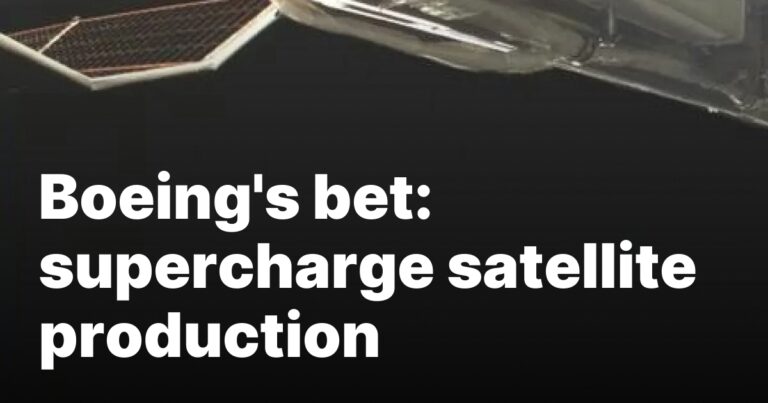Colorado Springs — Change is underway at Boeing Space Mission Systems. To meet growing demand, the veteran satellite manufacturer is creating hot production lines to accelerate deliveries and investing in technology to boost payload capability.
Two years after Boeing brought its satellite, ground systems and X-37B spaceplane under the Boeing Space Mission Systems umbrella, “we’re seeing the fruits of those labors,” said Michelle Parker, the Boeing vice president who leads the organization.
Boeing’s El Segundo, California, factory is busy producing Wideband Global Satcom (WGS) satellites for the U.S. military and O3b mPower communications satellites for operator SES. Nearby, small satellite subsidiary Millennium Space Systems is building eight satellites for the Space Development Agency’s Fire-control On Orbit-support-to-the-war Fighter (Foo Fighter) program and six satellites to detect and track missiles for the U.S. Space Force.
Parker spoke with SpaceNews’ Debra Werner.
Why are hot production lines, where subcontractors are supplying parts and building continues, important?
Parker: Hot production lines enable you to operate at scale. You set up your supply chain and define your build and test infrastructure to support a regular cadence. You can make upgrades as you go along. Production is streamlined because you’re not redesigning every time.
At Millennium, with orders coming in, we’re ramping up capability. And at Spectrolab, [another Boeing subsidiary] we’re investing in automation and increased capacity because we see the demand. Spectrolab had one of their best years ever last year.

Boeing is the prime contractor for the X-37B military spaceplane. What was important about the recent mission that concluded March 7?
This last mission was a game-changing demonstration. It landed after 434 days in orbit. It demonstrated [a] highly elliptical orbit for the first time and the ability to come back down to low-Earth orbit by aerobraking, using the atmosphere rather than burning propellant. Propellant is a valuable resource in space. To be able to do a maneuver of that magnitude without expending propellant is game changing. We’ve been flying that platform since 2010 and continually demonstrating new and innovative things with the platform, the experiments and the mission duration. The record mission duration was 908 days. All combined, we have over 10 years of life of the missions that have flown.
Is there an end in sight?
That’s a Space Force vehicle. They determine the cadence. We work very closely with them. Through the years, we’ve continually evolved the avionics and would look to continue to do that.
Last year, there was new leadership at Millennium. How is that changing the business?
CEO Tony Gingiss joined us in December. When we acquired Millennium in 2018, it built prototypes and delivered one or two satellites a year. They did that fantastically, but it was a startup. Millennium had 200 employees when we brought them into the Boeing family. We’re about to cross 1,000 employees and have roughly a 100-satellite backlog.
Because of the significant growth, we need that production mindset. Millennium is 75 to 80 percent vertically integrated. Tony brings that experience. He understands production at rate and has been able to make some big impacts.
Are you expanding the Millennium factory?
Yes. We are taking the blueprint for the original smallsat factory and replicating it to double the capacity. As orders continue to come in, we can triple it or whatnot. In the smallsat factory, everything can be moved around. That helps us build up where we need to and adjust.
Regarding Spectrolab, I’ve heard that radiation-hardened solar cells are one of the industry’s supply-chain bottlenecks.
Spectrolab has been part of our Hughes-Boeing family for 70 years. It services Boeing and external customers. In the past year or so, we’ve seen an increase in the demand. Spectrolab president Miquelle Milavec was able to increase the capacity. And we are investing to increase the automation.
Spectrolab produces highly efficient solar cells. Some less efficient cells might be less expensive, but you need more of them. If we can be successful with our investments in driving our price-point down, you could get high efficiency at maybe not lowest cost but lower cost.
What’s the latest on WGS?
We’ve got a constellation of 10 in orbit providing military satellite communication. WGS-11 and WGS-12 will be based on our integrated payload array technology that we first demonstrated on O3b. We’re excited about bringing more capability, more agility, more dynamic control to the WGS constellation. We hardened the integrated payload array for military applications with anti-jam and protected communications. And the anti-jam is autonomous on those vehicles.
What’s the status of O3b mPower?
We’re building 13 O3b mPower satellites. Six are in their orbital slots with traffic through them. We launched the seventh and eighth in December. They are currently in their orbit raising and will get to their orbital slots in late April. They’ll go through their testing and then join that constellation. We are finishing production on nine, 10 and 11. We’re launching those as a three stack. The others all launched in pairs.
Why is Boeing investing in photonics, quantum and AI?
Those are exciting areas not just in the space world, but overall. The key in a high-tech environment is to produce well what you have and look at what’s next, so you can introduce it in an evolutionary capacity.
Photonics allows you to have higher-rate throughput and frequency broadening in a very reduced size, weight and power. You can bring the size of the vehicles down, which allows simplicity of production, ease of launch, repeatability. I’m excited about the possibilities of photonics within the communications and imaging areas.
Quantum opens up a whole new realm, from a secure communications standpoint and the power of computing. I’m excited to see what possibilities it can bring.
We’re really looking to use AI within our production, in orbit and maybe within design as well.

